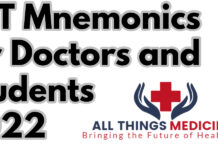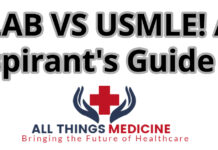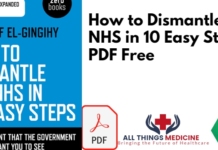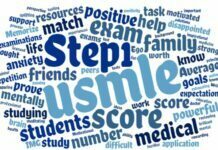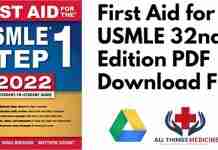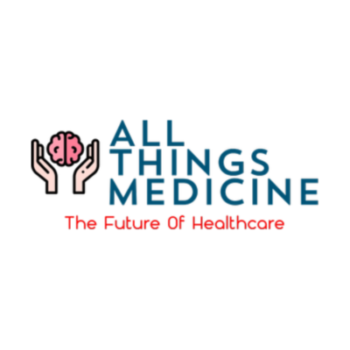Page Contents
Important mnemonics for USMLE takers
The USMLE exam is the toughest exam an IMG can choose for their career. This article focuses on making the toughest of the disease and syndromes of this toughest exam easier.
Kawasaki Disease
Crash and Burn
- Conjunctivitis (non-purulent)
- Rash
- Adenopathy (cervical and commonly unilateral)
- Strawberry tongue
- Hands (palmar erythema/swelling)
- Burn (fever lasting at least 5 days or more)
Complications of Myocardial infarction
DARTH VADER (from Starwars so watch the movie first)
- Death
- Arrhythmia
- Rupture (free ventricular wall, septum or papillary muscles)
- Tamponade
- Heart failure
- Valve disease
- Aneurysm of ventricle
- Dressler’s syndrome
- Embolism (mural thrombus)
- Recurrence/mitral Regurgitation
Acute Cardiac Tamponade – Beck’s Triad
3-D’s
- Distant heart sounds
- Decreased arterial blood pressure
- Distended Jugular Veins (JVD)
Acute Pancreatitis
BAD HITS
- Biliary
- Alcohol
- Drugs (Corticosteroids, HIV drugs, Diuretics, Valproic acid..)
- Hypertriglyceridemia/Hypercalcemia
- Idiopathic
- Trauma
- Scorpion Sting
Cushing Syndrome
CUSHING
- Central obesity, Collagen fiber weakness, Comedones (acne)
- Urinary free cortisol and glucose increase
- Striae, Suppressed immunity
- Hypercortisolism, Hypertension, Hyperglycemia, Hypercholesterolemia
- Latrogenic (increased administration of corticosteroids)
- Noniatrogenic (Neoplasms)
- Glucose intolerance, Growth retardation
Multiple endocrine neoplasias
- Pituitary tumors
- Parathyroid tumors
- Pancreatic endocrine tumors (e.g. Zollinger-Ellison syndrome, Insulinomas, VIPomas, Glucagonomas)
- Parathyroid tumor
- Medullary thyroid carcinoma
- Pheochromocytoma
- Mucosal neuromas/Marfanoid habitus
- Medullary Thyroid Carcinoma
- Pheochromocytoma
PHEochromocytoma
- Palpitations
- Headache
- Episodic sweating (diaphoresis)
Crohn’s Disease
CHRISTMAS
- Cobblestones
- High temperature
- Reduced lumen
- Intestinal fistulae
- Skip lesions
- Transmural (all layers, may ulcerate)
- Malabsorption
- Abdominal pain
- Submucosal fibrosis

Nephrotic Syndrome
NAPHROTIC
- Na decrease (hyponatremia)
- Albumin decrease (hypoalbuminemia)
- Proteinuria >3.5 g/day
- Hyperlipidemia
- Renal vein thrombosis
- Orbital edema
- Thromboembolism
- Infection (due to loss of immunoglobulins in urine)
- Coagulability (due to loss of antithrombin III in urine)
Tabes Dorsalis Morphology
DORSALIS
- Dorsal column degeneration
- Orthopedic pain (Charcot joints)
- Reflexes decreased (deep tendon)
- Shooting pain
- Argyll-Robertson pupils
- Locomotor ataxia
- Impaired proprioception
- Syphilis
ACE Inhibitor (side effects)
CAPTOPRIL
- Cough/C1 esterase deficiency Contraindication
- Angioedema/Agranulocytosis
- Proteinuria/Potassium excess (hyperkalemia)
- Taste change
- Orthostatic hypotension
- Pregnancy contraindication (fetal renal damage)
- Renal artery stenosis contraindication
- Increase renin
- Leukopenia/Liver toxicity

Class III Antiarrhythmic
IS BAD
- Ibutilide
- Sotalol
- Bretylium
- Amiodarone
- Dofetilide
H.Pylori Treatment
Please Make Tummy Better
- Proton pump inhibitor (omeprazole)
- Metronidazole
- Tetracycline
- Bismuth
Lithium Side effects
LTH
- Leukocytosis
- Inspidus (nephrogenic diabetes insipidus)
- Tremor/Teratogenic (ebstein’s anomaly)
- Hypothyroidism
Myocardial Infarction Treatment
MOAN
- Morphine
- Oxygen
- Aspirin
- Nitroglycerine
Statin’s Side effect
think of their MOA (inhibition of HMG-CoA reductase)
- Hepatotoxicity
- Myalgia, Myositis, rhabdoMyolysis
Stevens Johnson Syndrome causing drugs
- Phenytoin
- Carbamazepine
- Phenobarbital
- Lamotrigine
- Allopurinol
- Penicillin
- Sulfadrugs
- Erythromycin
Tuberculosis Treatment
If you forget your TB drugs, You will die and might need a PRIEST
- Pyrazinamide
- Rifampin
- Isoniazid
- Ethambutol
- STreptomycin
Acute Respiratory Distress Syndrome Causes
ARDS
- Aspiration/Acute pancreatitis/Air or Amniotic embolism
- Radiation
- Drug overdose/DIC/Drowning/Diffuse lung disease
- Shock/Sepsis/Smoke inhalation
Autosomal Dominant Disorders Mnemonics
Very Powerful DOMINANT Humans
- Von williebrand disease / Von Hippel-Lindau
- Pseudo-hypoparathyroidism
- Dystrophia myotonica
- Osteogenesis imperfecta/Osler-weber-rendu
- Marfan syndrome
- Intermittent porphyria
- Neurofibromatosis
- Achondroplasia/Adult polycystic kidney disease
- Noonan syndrome
- Tuberous sclerosis
- Hypercholesterolemia
- Huntington’s disease
- Hypertrophic obstructive cardiomyopathy
- Hereditary spherocytosis
- Hereditary non polyposis coli
- Hereditary hemorrhagic telangiectasia
Fabry’s Disease
FABRY’C (replace S with C)
- Foam cells/ Febrile episodes
- Alpha galactosidase A deficiency/Angiokeratomas
- Burning pain in hands and feet “peripheral neuropathy”/Boys
- Renal failure
- YX genotype (Male, X-linked recessive)
- Ceramide trihexoside accumulation/Cardiovascular disease
Folic Acid deficiency causes
- Alcoholism
- Folic acid antagonists (e.g methotrexate, trimethoprim)
- Oral contraceptives
- Low dietary intake (e.g. excessive goat milk)
- Infection with giardia
- Celiac sprue
- Pregnancy/Psoriasis
- Old age
- Dilantin aka phenytoin
Tay Sach’s Features
TAY SACHS
- Testing recommended
- Autosomal recessive
- Young death (<4 years)
- Spot in macula (cherry red spots)
- Ashkenazi jews
- CNS degeneration
- Hex A deficiency
- Storage disease
Acute Intermittent Porphyria
6 P’s
- Porphobilinogen deaminase deficiency
- Pain in abdomen (most common, 95% of patients experience)
- Psychological symptoms (Anxiety, agitation, hallucination, hysteria, delirium, depression)

Felty’s Syndrome
SANTA
- Splenomegaly
- Anemia
- Neutropenia
- Thrombocytopenia
- Arthritis (Rheumatoid)
Multiple Myeloma Signs and Symptoms
CRAB
- Calcium elevation
- Renal impairment
- Anemia
- Bone (bone pain, lytic lesions, fractures)
these were all important mnemonics for USMLE takers. You might find some useful mnemonics on pharmacology and surgery by clicking them. In the meantime if you want more information on USMLE and tips on USMLE click them.
Here are some tips specifically for the USMLE STEP 1 exam
https://allthingsmedicine.com/usmle-step-1-made-ridiculously-easy/
Brainstorm! BYE



